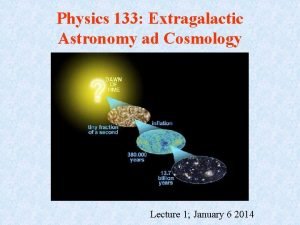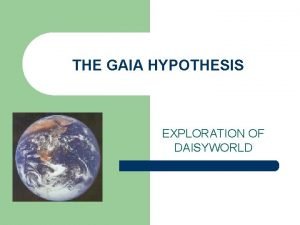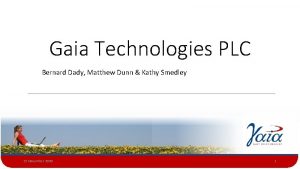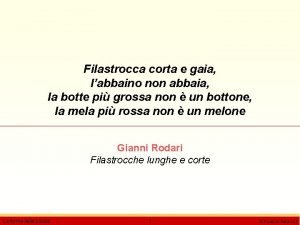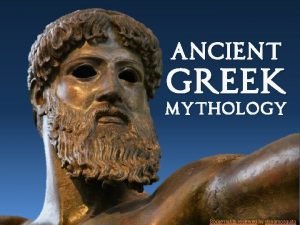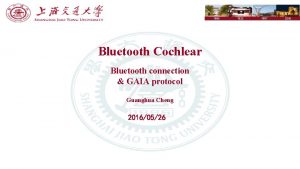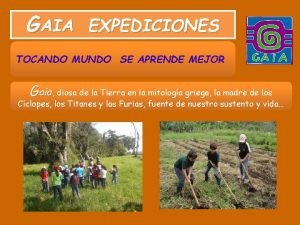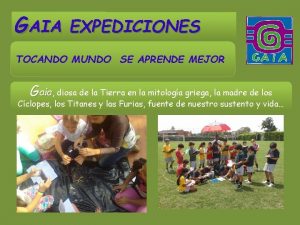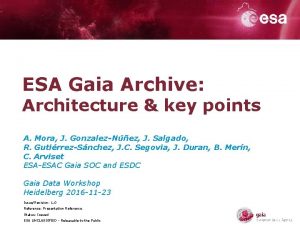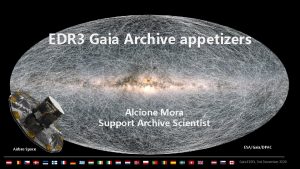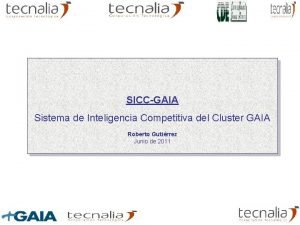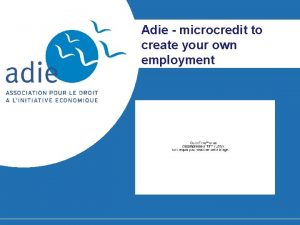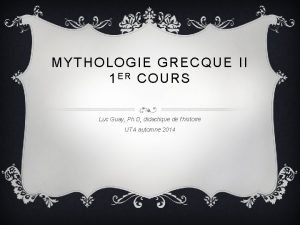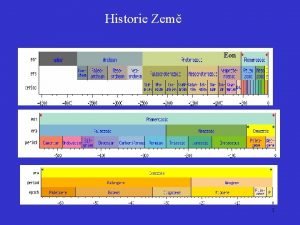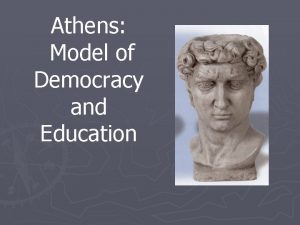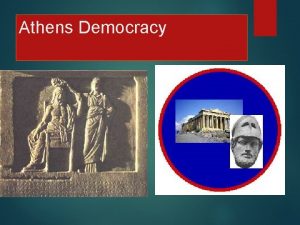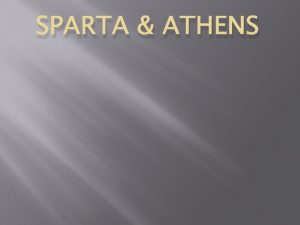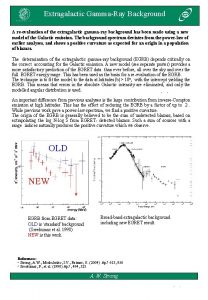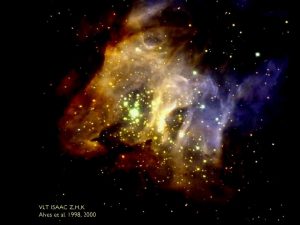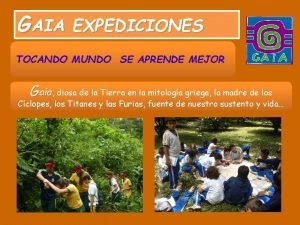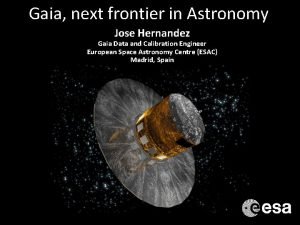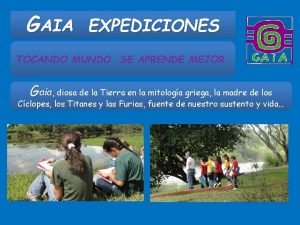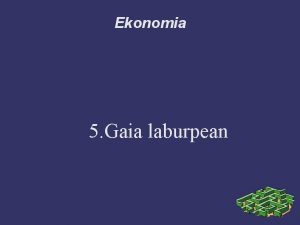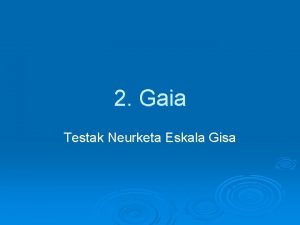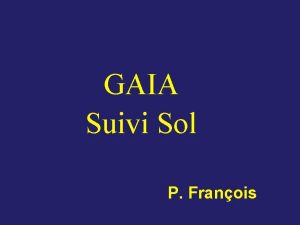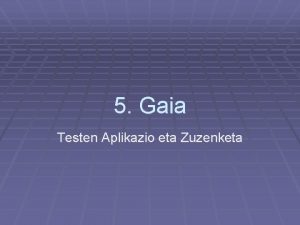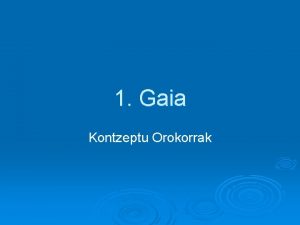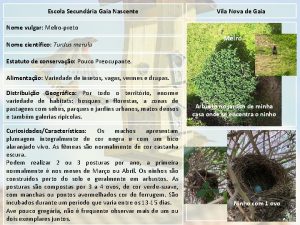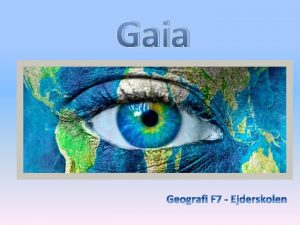Extragalactic science with Gaia Athens Gaia Group PI





















- Slides: 21

Extragalactic science with Gaia Athens Gaia Group PI Prof. Mary Kontizas • National and Kapodistrian University of Athens (NKUA) Co-PI • Ioannis Bellas-Velidis (National Observatory of Athens, NOA) Members: • Anastasios Dapergolas (NOA) • Evangelos Kontizas (NOA) • Evdokia Livanou (NKUA) • A. Karampelas (NKUA) • Petros Drazinos (NKUA) • Panagiotis Gavras (NKUA) • Despina Hatzidimitriou (NKUA) •

external collaborators • Prof. Brigitte Rocca-Volmerange, IAP, Paris • Dr. A. Vallenari, University of Padova • Dr. C. Bailer-Jones, MPIA, Heidelberg • Dr. Almeida, IAC, Spain

Brief information Gaia yes December 2013 1) To WHICH ESA MISSION we are involved? 2) Is Gaia launched ? Athens team’s involvement to Gaia 3) Subject assigned by ESA Unresolved galaxies (the only European team on this topic) 4) Since when we are working on the mission’s Since 2004 5) Funded by PRODEX 2012 -2014 6) Commitment of our participation till the end of mission

Gaia/ESA a space mission for astronomy Objectives The primary objective of the Gaia mission is to survey more than one billion stars in our Galaxy and beyond. Data from this astronomical census will allow astronomers to answer some fundamental questions about the formation and evolution of our Galaxy, and will provide insight into many other topical areas of astronomy. • While surveying the sky, Gaia is bound to make many other discoveries. During its anticipated lifetime of five years, Gaia will observe each of its one billion sources about 70 times, resulting in a record of the brightness and position of each source over time. !Data processing and Analysis had to be prepared by the European astronomical Community!

12 YEARS AGO In 2004 the first groups were created for Gaia data processing. The task on Unresolved Galaxies was not assigned to any group yet. Gaia was mainly designed for our GALAXY! We decided to take this subject, when most astronomers were sceptical about the question: How many unresolved galaxies will be observed by Gaia BP/RP? We calculated then that galaxies observed like point sources, were expected to be about a few times 106 galaxies. This large number of galaxies, opens important science topics such as galaxy evolution. NOW Since Gaia’s launch in late 2013!! it is found that a Large number (~2 millions) of unresolved galaxies are already observed by Gaia NKUA - NOA



Gaia Data Processing & Analysis Consortium DPAC CUs and DPCs The Data Processing & Analysis Consortium (DPAC) organigram shows the relation of the Coordination Units (CU), the Data Processing Centres (DPC) and the DPAC Executive Committee (DPACE) (slide 8 of 54)


Since 2007 the ATHENS Extragalactic Gaia team is participating to DPAC units CU 2 and CU 8 OUR TASKS FOR CU 8 DEVELOP THE SOFTWARE FOR THE UNRESOLVED GALAXIES DETECTED BY GAIA FOR CLASSIFICATION AND PARAMETRIZATION PURPOSES (UNRESOLVED GALAXY CLASSIFIER, UGC ). THIS IMPLIES THE FOLLOWING: 1) PRODUCE LIBRARIES OF THEORETICAL GALAXY SPECTRA. 2) COMPARE THEORETICAL LIBRARY WITH REAL SPECTRA FROM SDSS (SLOAN) AND INVESTIGATE (!!) THE CONSTRAINTS ENCOUNTERED IN ORDER TO PRODUCE A VERSION OF THE LIBRARY AS REALISTIC AS POSSIBLE. NKUA - NOA

TASKS FOR CU 2 Contribution to CU 2 -DU 3 «Universe Model» • Study nearby galaxies resolved in stars by Gaia. • Spatial Distribution of nearby galaxies as seen by Gaia • Estimate the number of stars from Gaia • Prepare an empirical library of galaxy spectra • Search for stellar structures in star forming regions at Gaia detection limit. NKUA - NOA

UGC for Gaia/DPAC/CU 8 – WHAT? UGC is a top-level workpackage GWP-S-832 of the Coordination Unit CU 8 “Astrophysical Parameters” of DPAC, the Data Processing and Analysis Consortium which is responsible for the Gaia’s scientific ground-based pipeline. q Algorithm development and implementation in a software for the DPAC’s pipeline is one of the main UGC tasks q The UGC goal is to classify the galaxy type and to estimate specific astrophysical parameters (extinction Ao, redshift z, star formation parameters Pi) of unresolved galaxies observed by Gaia analysing their BP/RP spectra. Galaxy spectra libraries production (synthetic and semi-empirical) is the second main UGC task q The libraries are necessary for the UGC development, for two other CU 8 packages, “Discrete Source Classifier” (GWP-S-821) and “Outlier Analysis” (GWP-S-836), as well as for the CU 2 Development Unit “Universe Model”.

Major Milestones under the ESA/PRODEX PROJECT (Ex. Sci. Gaia) PEA: 4000106135 May 2012 to April 2014 Tasks for CU 8 • Milestone 1: Library of synthetic galaxy spectra • Milestone 2: Performance qualification of UGC based on SVM models • Milestone 3: Spatial distribution models of resolved galaxies • Milestone 5: Statistical tests on the delivered library • Milestone 6: Performance tests of UGC based on ANN models and final qualification (end of April 2014) • Milestone 7: Light profiles of unresolved galaxies (end of April 2014) Task for CU 2 • Milestone 4: Simulations of the library data (end of January 2014)

The 18 months after launch and after PRODEX has finished in July 2014, we have to provide an assessment on the plausibility, quality, and correctness of the UGC results 1) Cross match of the first data with existing galaxy catalogues (WE NEED EXTRA FUNDING FOR THE FOLLOWING!) 2) to develop a validation procedure (algorithm, software, necessary inputs) and validation report form, 3) to deliver an updated version of the synthetic library of Galaxy spectra, and 4) to produce a semi-empirical library based on real data to be used for the validation.

Extragalactic Science with Gaia In 17 -18 October 2013 in Athens the meeting on extragalactic science with emphasis on the point sources like galaxies detected by Gaia funded by GREAT/ESF Many scientists from European Institutes of Padova (Italy), IAP, Bordeaux (France), IAC, IAA (Spain), Herstforshire and Athens (EKPA, NOA) have participated. NKUA - NOA

G 4 G – Gaia For Galaxies Scientific cases for Gaia unresolved galaxies • GALAXY EVOLUTION a very hot topic • Extragalactic sky as will be seen by Gaia (numbers to be fixed) • Compact red galaxies • Blue compact galaxies • Strong emission line galaxies • Morphology of galaxies • Luminous red galaxies • Brighter extension of the reference frame • Merging galaxies (? ) • Indices from Gaia spectra • Statistical Methods for classification/parametrization • Cross correlation with existing catalog data • Aperture effect on spectra NKUA - NOA

Athens Gaia Group: achievements q In DPAC: Since 2004 at DPAC initial stage, since 2007 officially accepted by ESA q Education: 4 Ph. Ds and 1 finishing, ? ? MSc q Dissemination: Publications (6 in referred journals), Presentations at Int. Conferences, Workshops and Meetings (>30, 12 published in proceedings), Meetings hosting (2007 CU 8, 2013 GREAT/EGSG), Public outreach (2014, Athens Planetarium), DPAC documents on Live. Link (>20, restricted access) q EU and GR programmes (GSRT/Athino. Gaia, EU/ITN-ELSA, EU/ESF GREAT, ESA/PRODEX) q UGC releases: Software: currently UGCv 16, Spectral libraries: (synthetic) Gal 1 Peg 2, Gal 2 o. Peg 2, Gal 3 Peg 2, Gal 4 Peg 2, (semi-empirical) Gal. SE 1, Gal. SE 2 ; Simulated libraries (by CU 2): GOG 3, GOG 5, GOG 6, GOG 7, GOG 8, GOG 11

ACKNOWLEDGMENTS 1) We acknowledge the significant support for this activity from the National and Kapodistrian University of Athens 2) We thank the National Observatory of Athens for the support all these years 3) The Greek General Secretariat of Research and Technology for the initial funding 4) The EU the financial support under the RTN, Marie Curie “ELSA” project 5) The funding from PRODEX/ESA project 6) The GREAT-ESF for financial support for the organisation of the meeting Ex. Sci. Gaia in 2013. NKUA - NOA

Ph. Ds obtained related to the preparation for Gaia 2007, Ε. Livanou “Large scale star formation in the Magellanic Clouds and their effect on the galaxies’ integrated spectra. Implementation for Gaia” 2007, P. Tsalmantza “Galaxy spectra and Classification of spectra for the Gaia/ ESA mission” 2011, Μ. Belcheva “Galaxies resolved in stars for Gaia Space Mission” 2012, A. Karampelas “Galaxy synthetic spectra for Gaia Space Mission” 2016, P. Drazinos, “Star Formation regions and stellar systems in nearby galaxies with data from HST and ground-based telescopes” NKUA - NOA

THANK YOU

 Extragalactic astronomy
Extragalactic astronomy Math is my favourite subject
Math is my favourite subject The gaia hypothesis
The gaia hypothesis Gaia wire cto
Gaia wire cto Gaia technologies
Gaia technologies Filastrocca corta e gaia
Filastrocca corta e gaia Gaia fund
Gaia fund Titanomach
Titanomach Gaia bluetooth
Gaia bluetooth 11. gaia diktadura frankista euskal herrian
11. gaia diktadura frankista euskal herrian Professor gaia
Professor gaia Chaos greek mythology family tree
Chaos greek mythology family tree Gaia expediciones
Gaia expediciones Gaia expediciones
Gaia expediciones Gaia archive
Gaia archive Gaia edr
Gaia edr Cluster gaia
Cluster gaia Adie telephone
Adie telephone Gaia and ouranos
Gaia and ouranos Gaia green all purpose 4-4-4
Gaia green all purpose 4-4-4 Mutter erde gaia
Mutter erde gaia Gaia
Gaia
